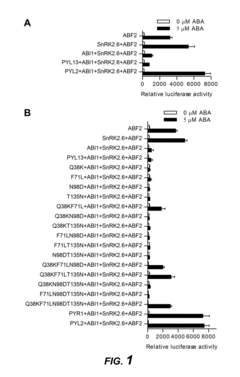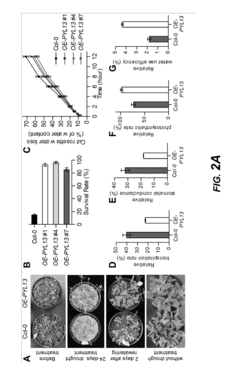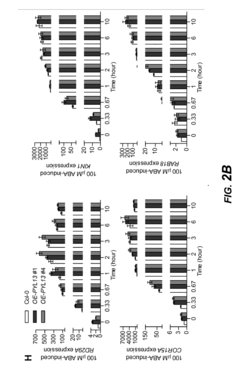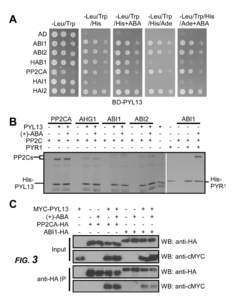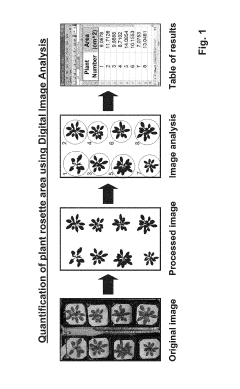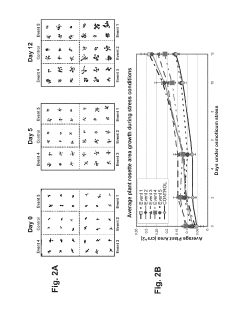How Abscisic Acid Enhances Abiotic Stress Management Techniques?
JUL 14, 20259 MIN READ
Generate Your Research Report Instantly with AI Agent
Patsnap Eureka helps you evaluate technical feasibility & market potential.
ABA and Stress Management: Background and Objectives
Abscisic acid (ABA) is a crucial plant hormone that plays a pivotal role in regulating plant responses to various abiotic stresses. The study of ABA's involvement in stress management techniques has gained significant attention in recent years due to the increasing challenges posed by climate change and environmental degradation. This research aims to explore how ABA enhances abiotic stress management techniques, with a focus on its mechanisms and potential applications in agriculture and plant biotechnology.
The evolution of ABA research can be traced back to the 1960s when it was first identified as a growth inhibitor. Since then, our understanding of ABA's functions has expanded dramatically, revealing its complex roles in plant development and stress responses. The hormone's ability to mediate plant responses to drought, salinity, cold, and other abiotic stresses has made it a key target for improving crop resilience and productivity in challenging environments.
Recent technological advancements, particularly in molecular biology and genetics, have accelerated our understanding of ABA signaling pathways and stress response mechanisms. The discovery of ABA receptors and the elucidation of ABA-dependent gene expression networks have provided new insights into how plants perceive and respond to environmental stresses. These breakthroughs have opened up new avenues for developing stress-tolerant crops and innovative stress management strategies.
The primary objective of this research is to comprehensively analyze the mechanisms by which ABA enhances abiotic stress management techniques. This includes investigating ABA biosynthesis, signaling cascades, and downstream effects on plant physiology and metabolism. Additionally, we aim to explore the potential applications of ABA-mediated stress management in agriculture, focusing on strategies to improve crop yield and quality under adverse environmental conditions.
Furthermore, this study seeks to identify emerging trends and future directions in ABA research, particularly in the context of climate change adaptation. By examining the latest developments in ABA-related biotechnology, including genetic engineering and precision agriculture, we aim to provide insights into innovative approaches for enhancing plant stress tolerance and resilience.
The significance of this research extends beyond academic interest, as it has direct implications for global food security and sustainable agriculture. As the world faces increasing environmental challenges, understanding and harnessing ABA's potential in stress management could play a crucial role in developing climate-smart agricultural practices and ensuring food production in the face of changing environmental conditions.
The evolution of ABA research can be traced back to the 1960s when it was first identified as a growth inhibitor. Since then, our understanding of ABA's functions has expanded dramatically, revealing its complex roles in plant development and stress responses. The hormone's ability to mediate plant responses to drought, salinity, cold, and other abiotic stresses has made it a key target for improving crop resilience and productivity in challenging environments.
Recent technological advancements, particularly in molecular biology and genetics, have accelerated our understanding of ABA signaling pathways and stress response mechanisms. The discovery of ABA receptors and the elucidation of ABA-dependent gene expression networks have provided new insights into how plants perceive and respond to environmental stresses. These breakthroughs have opened up new avenues for developing stress-tolerant crops and innovative stress management strategies.
The primary objective of this research is to comprehensively analyze the mechanisms by which ABA enhances abiotic stress management techniques. This includes investigating ABA biosynthesis, signaling cascades, and downstream effects on plant physiology and metabolism. Additionally, we aim to explore the potential applications of ABA-mediated stress management in agriculture, focusing on strategies to improve crop yield and quality under adverse environmental conditions.
Furthermore, this study seeks to identify emerging trends and future directions in ABA research, particularly in the context of climate change adaptation. By examining the latest developments in ABA-related biotechnology, including genetic engineering and precision agriculture, we aim to provide insights into innovative approaches for enhancing plant stress tolerance and resilience.
The significance of this research extends beyond academic interest, as it has direct implications for global food security and sustainable agriculture. As the world faces increasing environmental challenges, understanding and harnessing ABA's potential in stress management could play a crucial role in developing climate-smart agricultural practices and ensuring food production in the face of changing environmental conditions.
Market Demand for ABA-based Stress Management Solutions
The market demand for ABA-based stress management solutions in agriculture has been steadily increasing due to the growing challenges posed by climate change and environmental stressors. Farmers and agricultural businesses are increasingly seeking innovative methods to protect their crops and enhance yield under adverse conditions, driving the demand for ABA-related products and technologies.
The global agricultural biologicals market, which includes ABA-based solutions, is experiencing significant growth. This market segment is expected to expand at a compound annual growth rate (CAGR) of over 13% in the coming years, reflecting the rising interest in sustainable and environmentally friendly crop protection methods.
Abiotic stress factors, such as drought, salinity, and extreme temperatures, are responsible for substantial crop losses worldwide. These challenges have created a pressing need for effective stress management techniques, with ABA-based solutions emerging as a promising avenue. The ability of ABA to regulate plant responses to various environmental stressors makes it an attractive option for farmers looking to mitigate crop damage and maintain productivity.
The demand for ABA-based products is particularly strong in regions prone to drought and water scarcity. As water resources become increasingly scarce in many agricultural areas, farmers are turning to ABA-based solutions to improve water use efficiency and drought tolerance in their crops. This trend is especially pronounced in arid and semi-arid regions, where water management is a critical concern.
The horticultural sector has also shown growing interest in ABA-based stress management techniques. Greenhouse and nursery operators are exploring the use of ABA to enhance the stress tolerance of ornamental plants and improve their shelf life. This application has opened up new market opportunities in the floriculture and landscaping industries.
In addition to crop protection, there is an emerging market for ABA-based solutions in seed treatment. Seed companies are investigating the potential of ABA to enhance seed vigor and improve germination rates under stressful conditions. This application could significantly impact the seed industry and provide farmers with more resilient crop varieties.
The increasing focus on sustainable agriculture and reduced chemical inputs has further boosted the demand for ABA-based stress management solutions. As consumers and regulators push for more environmentally friendly farming practices, ABA-based products offer a natural alternative to traditional synthetic pesticides and growth regulators.
However, the market for ABA-based solutions still faces challenges, including the need for more extensive field trials and regulatory approvals. As research continues to demonstrate the efficacy and safety of ABA-based products, it is expected that market demand will continue to grow, driven by the pressing need for effective abiotic stress management techniques in agriculture.
The global agricultural biologicals market, which includes ABA-based solutions, is experiencing significant growth. This market segment is expected to expand at a compound annual growth rate (CAGR) of over 13% in the coming years, reflecting the rising interest in sustainable and environmentally friendly crop protection methods.
Abiotic stress factors, such as drought, salinity, and extreme temperatures, are responsible for substantial crop losses worldwide. These challenges have created a pressing need for effective stress management techniques, with ABA-based solutions emerging as a promising avenue. The ability of ABA to regulate plant responses to various environmental stressors makes it an attractive option for farmers looking to mitigate crop damage and maintain productivity.
The demand for ABA-based products is particularly strong in regions prone to drought and water scarcity. As water resources become increasingly scarce in many agricultural areas, farmers are turning to ABA-based solutions to improve water use efficiency and drought tolerance in their crops. This trend is especially pronounced in arid and semi-arid regions, where water management is a critical concern.
The horticultural sector has also shown growing interest in ABA-based stress management techniques. Greenhouse and nursery operators are exploring the use of ABA to enhance the stress tolerance of ornamental plants and improve their shelf life. This application has opened up new market opportunities in the floriculture and landscaping industries.
In addition to crop protection, there is an emerging market for ABA-based solutions in seed treatment. Seed companies are investigating the potential of ABA to enhance seed vigor and improve germination rates under stressful conditions. This application could significantly impact the seed industry and provide farmers with more resilient crop varieties.
The increasing focus on sustainable agriculture and reduced chemical inputs has further boosted the demand for ABA-based stress management solutions. As consumers and regulators push for more environmentally friendly farming practices, ABA-based products offer a natural alternative to traditional synthetic pesticides and growth regulators.
However, the market for ABA-based solutions still faces challenges, including the need for more extensive field trials and regulatory approvals. As research continues to demonstrate the efficacy and safety of ABA-based products, it is expected that market demand will continue to grow, driven by the pressing need for effective abiotic stress management techniques in agriculture.
Current State of ABA Research in Abiotic Stress Management
Abscisic acid (ABA) research in abiotic stress management has made significant strides in recent years, revealing its crucial role in plant responses to environmental challenges. Current studies focus on understanding the molecular mechanisms of ABA signaling and its interaction with other stress response pathways.
ABA biosynthesis and signaling pathways have been extensively mapped, with key enzymes and receptors identified. The PYR/PYL/RCAR family of ABA receptors and their interaction with PP2C phosphatases and SnRK2 kinases form the core of the ABA signaling cascade. This knowledge has enabled researchers to develop strategies for enhancing plant stress tolerance through genetic manipulation of these pathways.
Transcriptomics and proteomics approaches have uncovered numerous ABA-responsive genes and proteins involved in stress adaptation. These include transcription factors, ion channels, and enzymes involved in osmolyte production and antioxidant defense. The complex network of ABA-mediated gene regulation is being unraveled, providing insights into the broader stress response mechanisms in plants.
Recent research has highlighted the crosstalk between ABA and other phytohormones in stress responses. Interactions with jasmonic acid, ethylene, and salicylic acid pathways have been demonstrated, revealing a sophisticated hormonal balance that fine-tunes plant responses to various environmental stresses.
Epigenetic regulation of ABA-mediated stress responses is an emerging area of study. DNA methylation, histone modifications, and small RNAs have been shown to play important roles in modulating ABA sensitivity and stress memory in plants. This research opens new avenues for developing stress-tolerant crops with improved long-term adaptation capabilities.
Field studies and crop improvement efforts are translating laboratory findings into practical applications. ABA analogs and biosynthesis inhibitors are being tested as potential agrochemicals for enhancing crop stress tolerance. Additionally, genetic engineering approaches targeting ABA-related genes have shown promise in developing drought-resistant and salt-tolerant crop varieties.
Cutting-edge technologies such as CRISPR-Cas9 gene editing are being employed to fine-tune ABA responses in plants. These precision breeding techniques allow for targeted modifications of ABA-related genes, potentially accelerating the development of stress-resilient crops.
The integration of systems biology approaches is providing a more holistic understanding of ABA's role in stress management. Computational models are being developed to predict plant responses to complex environmental scenarios, incorporating ABA signaling networks and their interactions with other cellular processes.
ABA biosynthesis and signaling pathways have been extensively mapped, with key enzymes and receptors identified. The PYR/PYL/RCAR family of ABA receptors and their interaction with PP2C phosphatases and SnRK2 kinases form the core of the ABA signaling cascade. This knowledge has enabled researchers to develop strategies for enhancing plant stress tolerance through genetic manipulation of these pathways.
Transcriptomics and proteomics approaches have uncovered numerous ABA-responsive genes and proteins involved in stress adaptation. These include transcription factors, ion channels, and enzymes involved in osmolyte production and antioxidant defense. The complex network of ABA-mediated gene regulation is being unraveled, providing insights into the broader stress response mechanisms in plants.
Recent research has highlighted the crosstalk between ABA and other phytohormones in stress responses. Interactions with jasmonic acid, ethylene, and salicylic acid pathways have been demonstrated, revealing a sophisticated hormonal balance that fine-tunes plant responses to various environmental stresses.
Epigenetic regulation of ABA-mediated stress responses is an emerging area of study. DNA methylation, histone modifications, and small RNAs have been shown to play important roles in modulating ABA sensitivity and stress memory in plants. This research opens new avenues for developing stress-tolerant crops with improved long-term adaptation capabilities.
Field studies and crop improvement efforts are translating laboratory findings into practical applications. ABA analogs and biosynthesis inhibitors are being tested as potential agrochemicals for enhancing crop stress tolerance. Additionally, genetic engineering approaches targeting ABA-related genes have shown promise in developing drought-resistant and salt-tolerant crop varieties.
Cutting-edge technologies such as CRISPR-Cas9 gene editing are being employed to fine-tune ABA responses in plants. These precision breeding techniques allow for targeted modifications of ABA-related genes, potentially accelerating the development of stress-resilient crops.
The integration of systems biology approaches is providing a more holistic understanding of ABA's role in stress management. Computational models are being developed to predict plant responses to complex environmental scenarios, incorporating ABA signaling networks and their interactions with other cellular processes.
Existing ABA-based Stress Management Techniques
01 Genetic modification for ABA-mediated stress tolerance
Genetic engineering techniques are used to enhance plants' ability to produce or respond to abscisic acid (ABA), improving their tolerance to various abiotic stresses such as drought, salinity, and extreme temperatures. This approach involves modifying genes related to ABA biosynthesis, signaling, or response pathways.- Genetic modification for ABA-mediated stress tolerance: Genetic engineering techniques are used to enhance plants' ability to produce or respond to abscisic acid (ABA), improving their tolerance to various abiotic stresses such as drought, salinity, and extreme temperatures. This approach involves modifying genes related to ABA biosynthesis, signaling, or response pathways.
- ABA analogs and synthetic compounds for stress management: Development and application of ABA analogs or synthetic compounds that mimic ABA's effects on plants. These substances can be applied exogenously to crops to enhance their stress tolerance without the need for genetic modification, offering a more flexible approach to abiotic stress management.
- ABA-responsive gene identification and manipulation: Identification and characterization of genes that are responsive to ABA or involved in ABA-mediated stress responses. These genes can be used as markers for stress tolerance or manipulated to enhance plants' ability to cope with abiotic stresses.
- ABA signaling pathway enhancement: Strategies to enhance or modify the ABA signaling pathway in plants, including the manipulation of ABA receptors, transcription factors, and other signaling components. This approach aims to improve plants' sensitivity to ABA and their overall stress response mechanisms.
- Integration of ABA with other stress management techniques: Combining ABA-based approaches with other abiotic stress management techniques, such as the use of compatible solutes, antioxidants, or other phytohormones. This integrated approach aims to provide comprehensive protection against multiple abiotic stresses and enhance overall plant resilience.
02 ABA-responsive promoter systems
Development of ABA-responsive promoter systems that can be used to control gene expression in response to abiotic stress conditions. These systems allow for the targeted activation of stress-tolerance genes when plants encounter adverse environmental conditions, enhancing their ability to cope with stress.Expand Specific Solutions03 Exogenous application of ABA and analogs
Methods for applying ABA or its synthetic analogs to plants externally, either through foliar sprays, seed treatments, or soil applications. This approach aims to boost the plants' natural stress response mechanisms and improve their resilience to abiotic stresses without genetic modification.Expand Specific Solutions04 ABA signaling pathway manipulation
Strategies to manipulate the ABA signaling pathway components, such as receptors, transcription factors, and downstream effectors, to enhance plant stress tolerance. This includes developing compounds that can modulate ABA signaling or identifying and modifying key regulatory elements in the pathway.Expand Specific Solutions05 Integration of ABA with other stress management approaches
Combining ABA-based strategies with other abiotic stress management techniques, such as the use of compatible solutes, antioxidants, or other phytohormones. This integrated approach aims to provide comprehensive protection against multiple stress factors and improve overall plant resilience.Expand Specific Solutions
Key Players in ABA and Stress Management Research
The field of abscisic acid (ABA) in abiotic stress management is in a growth phase, with increasing market potential as climate change exacerbates environmental stresses on crops. The global market for plant growth regulators, including ABA, is projected to reach several billion dollars by 2025. Technologically, ABA research is advancing rapidly, with key players like Evogene, Valent BioSciences, and Syngenta leading innovation. Universities such as the University of California and China Agricultural University are contributing significant basic research. While ABA applications are becoming more sophisticated, challenges remain in optimizing delivery methods and understanding complex plant responses, indicating room for further technological maturation and market expansion.
The Regents of the University of California
Technical Solution: The University of California has developed a comprehensive approach to enhance abiotic stress management using abscisic acid (ABA). Their research focuses on understanding the molecular mechanisms of ABA signaling and its role in stress response. They have identified key ABA receptors and downstream signaling components, such as the PYR/PYL/RCAR protein family[1]. Their technique involves modulating these receptors to enhance plant drought tolerance. Additionally, they have engineered plants with improved ABA sensitivity, resulting in better water use efficiency and increased crop yield under drought conditions[2]. The university has also explored the use of ABA analogs and small molecule agonists to activate stress response pathways more effectively[3].
Strengths: Comprehensive understanding of ABA signaling pathways, proven success in enhancing drought tolerance. Weaknesses: Potential regulatory hurdles for genetically modified crops, need for extensive field testing.
Evogene Ltd.
Technical Solution: Evogene Ltd. has developed a computational biology platform called Gene2Product™ to enhance abiotic stress management using ABA-related genes. Their approach involves identifying and optimizing key genes involved in ABA biosynthesis, signaling, and response pathways. They use advanced algorithms to predict gene function and interactions, allowing for targeted genetic modifications to improve plant stress tolerance[4]. Evogene has successfully identified novel ABA-responsive transcription factors that, when overexpressed, lead to improved drought and salt tolerance in various crops[5]. Their technology also includes the development of ABA-responsive promoters that can be used to fine-tune stress response gene expression, providing a more precise control over plant stress management[6].
Strengths: Advanced computational biology approach, ability to identify novel genes and regulatory elements. Weaknesses: Reliance on genetic modification techniques, which may face regulatory and public acceptance challenges.
Core Innovations in ABA Signaling Pathways
Drought tolerant transgenic plants and method of making same
PatentActiveUS20150074844A1
Innovation
- Over-expression of the PYL13 protein, which interacts with clade A PP2Cs in an ABA-independent manner, constitutively inhibiting their activity and promoting drought resistance without the need for elevated ABA levels, thereby accelerating stress-responsive gene expression and improving drought tolerance.
Methods of increasing abiotic stress tolerance and/or biomass in plants and plants generated thereby
PatentActiveUS20190161767A1
Innovation
- Expression of exogenous polynucleotides encoding polypeptides with amino acid sequences at least 90% homologous to specific sequences (e.g., SEQ ID NO: 2, 4, 6, 8, 10, 12, 13-56, 58-63, 66-119, 139-154 or 155) within plants to enhance their tolerance to abiotic stresses, achieved by transforming plant cells with nucleic acid constructs including these polynucleotides and suitable promoters for transcription.
Environmental Impact of ABA-based Agricultural Practices
The implementation of ABA-based agricultural practices has significant environmental implications, both positive and negative. On the positive side, these practices can lead to more efficient water use in agriculture, reducing the overall water footprint of crop production. This is particularly important in water-scarce regions, where ABA-induced drought tolerance can help conserve precious water resources. Additionally, the enhanced stress management capabilities of crops treated with ABA can result in reduced use of chemical pesticides and fertilizers, as plants become more resilient to environmental stressors.
However, the widespread use of ABA in agriculture also raises concerns about potential ecological impacts. The introduction of synthetic ABA or ABA-mimicking compounds into the environment may affect non-target organisms, including beneficial insects and soil microorganisms. There is a need for comprehensive studies on the long-term effects of these compounds on ecosystem biodiversity and soil health.
Furthermore, the increased stress tolerance of ABA-treated crops may inadvertently lead to the expansion of agriculture into marginal lands that were previously considered unsuitable for cultivation. While this could potentially increase food production, it may also result in the loss of natural habitats and contribute to land degradation if not managed sustainably.
The impact on soil quality is another important consideration. ABA-induced changes in root architecture and exudation patterns may alter soil microbial communities and nutrient cycling processes. While some of these changes could be beneficial, such as improved nutrient uptake efficiency, others may disrupt established ecological balances in the soil ecosystem.
From a climate change perspective, ABA-based practices could have mixed effects. On one hand, improved water use efficiency and stress tolerance could reduce the need for energy-intensive irrigation and crop protection measures, potentially lowering greenhouse gas emissions from agriculture. On the other hand, if these practices lead to intensification of agriculture or expansion into new areas, it could result in increased carbon emissions from land-use changes.
The environmental impact of ABA-based agricultural practices also extends to water quality. While reduced use of agrochemicals is generally positive for water systems, the potential leaching of synthetic ABA or its metabolites into groundwater and surface water bodies needs to be carefully monitored and assessed for any adverse effects on aquatic ecosystems.
However, the widespread use of ABA in agriculture also raises concerns about potential ecological impacts. The introduction of synthetic ABA or ABA-mimicking compounds into the environment may affect non-target organisms, including beneficial insects and soil microorganisms. There is a need for comprehensive studies on the long-term effects of these compounds on ecosystem biodiversity and soil health.
Furthermore, the increased stress tolerance of ABA-treated crops may inadvertently lead to the expansion of agriculture into marginal lands that were previously considered unsuitable for cultivation. While this could potentially increase food production, it may also result in the loss of natural habitats and contribute to land degradation if not managed sustainably.
The impact on soil quality is another important consideration. ABA-induced changes in root architecture and exudation patterns may alter soil microbial communities and nutrient cycling processes. While some of these changes could be beneficial, such as improved nutrient uptake efficiency, others may disrupt established ecological balances in the soil ecosystem.
From a climate change perspective, ABA-based practices could have mixed effects. On one hand, improved water use efficiency and stress tolerance could reduce the need for energy-intensive irrigation and crop protection measures, potentially lowering greenhouse gas emissions from agriculture. On the other hand, if these practices lead to intensification of agriculture or expansion into new areas, it could result in increased carbon emissions from land-use changes.
The environmental impact of ABA-based agricultural practices also extends to water quality. While reduced use of agrochemicals is generally positive for water systems, the potential leaching of synthetic ABA or its metabolites into groundwater and surface water bodies needs to be carefully monitored and assessed for any adverse effects on aquatic ecosystems.
Regulatory Framework for ABA-derived Crop Protection Products
The regulatory framework for ABA-derived crop protection products is a critical aspect of their development and commercialization. As abscisic acid (ABA) gains recognition for its potential in enhancing abiotic stress management techniques, regulatory bodies worldwide are adapting their guidelines to accommodate these novel products.
In the United States, the Environmental Protection Agency (EPA) oversees the registration and regulation of ABA-derived crop protection products under the Federal Insecticide, Fungicide, and Rodenticide Act (FIFRA). The EPA has established specific guidelines for biopesticides, including plant growth regulators like ABA, which require less stringent testing compared to conventional pesticides due to their perceived lower risk profile.
The European Union, through the European Food Safety Authority (EFSA), has implemented a comprehensive regulatory framework for plant protection products, including those derived from ABA. The EU's approach emphasizes the importance of safety assessments and environmental impact studies before granting market authorization.
In Japan, the Ministry of Agriculture, Forestry and Fisheries (MAFF) regulates ABA-derived products under the Agricultural Chemicals Regulation Act. The Japanese regulatory system places a strong emphasis on efficacy data and crop-specific applications.
Developing countries are also establishing regulatory frameworks for ABA-derived products, often modeled after established systems in developed nations. However, these frameworks may be less comprehensive due to limited resources and expertise.
International organizations, such as the Food and Agriculture Organization (FAO) and the World Health Organization (WHO), provide guidelines and standards for the regulation of plant protection products, including those derived from ABA. These guidelines aim to harmonize regulatory approaches across different countries and ensure the safe use of these products globally.
Key regulatory considerations for ABA-derived crop protection products include efficacy data, toxicological assessments, environmental fate studies, and residue analysis. Regulatory bodies typically require extensive field trials to demonstrate the product's effectiveness in managing abiotic stress and its impact on crop yield and quality.
As research continues to uncover new applications and formulations of ABA for abiotic stress management, regulatory frameworks are expected to evolve. This may include the development of specific guidelines for ABA-derived products, streamlined registration processes, and increased collaboration between regulatory agencies to facilitate global market access.
In the United States, the Environmental Protection Agency (EPA) oversees the registration and regulation of ABA-derived crop protection products under the Federal Insecticide, Fungicide, and Rodenticide Act (FIFRA). The EPA has established specific guidelines for biopesticides, including plant growth regulators like ABA, which require less stringent testing compared to conventional pesticides due to their perceived lower risk profile.
The European Union, through the European Food Safety Authority (EFSA), has implemented a comprehensive regulatory framework for plant protection products, including those derived from ABA. The EU's approach emphasizes the importance of safety assessments and environmental impact studies before granting market authorization.
In Japan, the Ministry of Agriculture, Forestry and Fisheries (MAFF) regulates ABA-derived products under the Agricultural Chemicals Regulation Act. The Japanese regulatory system places a strong emphasis on efficacy data and crop-specific applications.
Developing countries are also establishing regulatory frameworks for ABA-derived products, often modeled after established systems in developed nations. However, these frameworks may be less comprehensive due to limited resources and expertise.
International organizations, such as the Food and Agriculture Organization (FAO) and the World Health Organization (WHO), provide guidelines and standards for the regulation of plant protection products, including those derived from ABA. These guidelines aim to harmonize regulatory approaches across different countries and ensure the safe use of these products globally.
Key regulatory considerations for ABA-derived crop protection products include efficacy data, toxicological assessments, environmental fate studies, and residue analysis. Regulatory bodies typically require extensive field trials to demonstrate the product's effectiveness in managing abiotic stress and its impact on crop yield and quality.
As research continues to uncover new applications and formulations of ABA for abiotic stress management, regulatory frameworks are expected to evolve. This may include the development of specific guidelines for ABA-derived products, streamlined registration processes, and increased collaboration between regulatory agencies to facilitate global market access.
Unlock deeper insights with Patsnap Eureka Quick Research — get a full tech report to explore trends and direct your research. Try now!
Generate Your Research Report Instantly with AI Agent
Supercharge your innovation with Patsnap Eureka AI Agent Platform!
